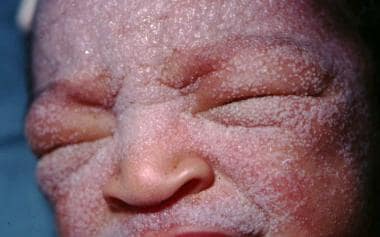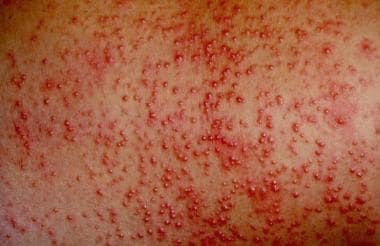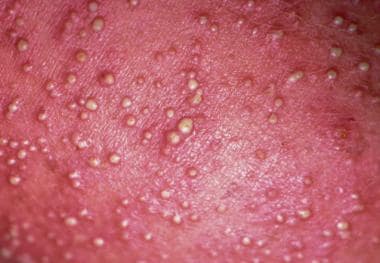Background
Miliaria is a common disorder of the eccrine sweat glands that often occurs in conditions of increased heat and humidity. Miliaria is thought to be caused by blockage of the sweat ducts, which results in the leakage of eccrine sweat into the epidermis or dermis. [1, 2] Note the image below.
See 13 Common-to-Rare Infant Skin Conditions, a Critical Images slideshow, to help identify rashes, birthmarks, and other skin conditions encountered in infants.
The 3 types of miliaria are classified according to the level at which obstruction of the sweat duct occurs. In miliaria crystallina, ductal obstruction is most superficial, occurring in the stratum corneum. Clinically, this form of the disease produces tiny, fragile, clear vesicles. In miliaria rubra, obstruction occurs deeper within the epidermis and results in extremely pruritic erythematous papules. In miliaria profunda, ductal obstruction occurs at the dermal-epidermal junction. Sweat leaks into the papillary dermis and produces subtle asymptomatic flesh-colored papules. When pustules develop in lesions of miliaria rubra, the term miliaria pustulosa is used. Note the images below.
Miliaria rubra can cause great discomfort, and miliaria profunda may lead to heat exhaustion. Treatment of these conditions is warranted. See Heat Illness: How To Cool Off Hyperthermic Patients, a Critical Images slideshow, for tips on treatment options for these patients.
Pathophysiology
The primary stimuli for the development of miliaria are conditions of high heat and humidity that lead to excessive sweating. Occlusion of the skin due to clothing, bandages, transdermal medication patches, [3] or plastic sheets (in an experimental setting) can further contribute to pooling of sweat on the skin surface and overhydration of the stratum corneum. In susceptible persons, including infants, who have relatively immature eccrine glands, overhydration of the stratum corneum is thought to be sufficient to cause transient blockage of the acrosyringium. Foxc1 knockout in mice produces miliaria, suggesting a genetic predisposition may exist. [4]
If hot humid conditions persist, the individual continues to produce excessive sweat, but he or she is unable to secrete the sweat onto the skin surface because of ductal blockage. This blockage results in the leakage of sweat en route to the skin surface, either in the dermis or epidermis, with relative anhidrosis.
When the point of leakage is in the stratum corneum or just below it, as in miliaria crystallina, little accompanying inflammation is present, and the lesions are asymptomatic. In contrast, in miliaria rubra, the leakage of sweat into the subcorneal layers produces spongiotic vesicles and a chronic periductal inflammatory cell infiltrate in the papillary dermis and lower epidermis. In miliaria profunda, the escape of sweat into the papillary dermis generates a substantial, periductal lymphocytic infiltrate and spongiosis of the intra-epidermal duct.
Resident skin bacteria, such as Staphylococcus epidermidis and Staphylococcus aureus, are thought to play a role in the pathogenesis of miliaria, possibly through formation of biofilms. [5, 6] Patients with miliaria have three times as many bacteria per unit area of skin as healthy control subjects. Antimicrobial agents are effective in suppressing experimentally induced miliaria. Periodic acid-Schiff-positive diastase-resistant material has been found in the intraductal plug that is consistent with staphylococcal extracellular polysaccharide substance (EPS). In an experimental setting, only the strains of S epidermidis that produce EPS can induce miliaria. [7]
In late-stage miliaria, hyperkeratosis and parakeratosis of the acrosyringium are observed. A hyperkeratotic plug may appear to obstruct the eccrine duct, but this is now believed to be a late change and not the precipitating cause of the sweat blockage.
Etiology
The following causes are recognized:
-
Immaturity of the eccrine ducts: Neonates are thought to have immature eccrine ducts that easily rupture when sweating is induced; this rupture leads to miliaria.
-
Occlusion of the skin, as with transdermal drug patches [3]
-
Occlusive clothing: Eighteen cases of miliaria rubra have been reported in US Army personnel who routinely wore flame-resistant army combat uniforms composed of a 65% rayon/25% Kevlar/10% nylon blend while serving in the hot, arid conditions of Afghanistan. [8]
-
Lack of acclimatization: Miliaria is common in individuals who move from a temperate climate to a tropical climate. The condition usually resolves after the individual has lived in the hot, humid conditions for many months.
-
Hot, humid conditions: Tropical climates, incubators in neonatal nurseries, and febrile illnesses may precipitate miliaria.
-
Exertion or high fever: Any stimulus to sweat may precipitate or exacerbate miliaria.
-
Type I pseudohypoaldosteronism: This disorder of mineralocorticoid resistance leads to excessive loss of salt through eccrine secretions and is associated with repeated episodes of pustular miliaria rubra. [9, 10, 11]
-
Morvan syndrome: Miliaria rubra has been reported in this rare autoimmune disorder characterized by neuromyotonia, insomnia, hallucinations, pain, weight loss, and hyperhidrosis. [12]
-
Drugs: Bethanechol, a drug that promotes sweating, has been reported to cause miliaria, as have clonidine and neostigmine. [13] Isotretinoin, a drug that affects follicular differentiation, also has been reported to cause miliaria. [14] Miliaria crystallina has been reported following administration of doxorubicin or erythropoietin. [15, 16]
-
Bacteria: Staphylococci are associated with miliaria, and antibiotics prevent miliaria in an experimental setting.
-
Ultraviolet radiation: Some researchers found that miliaria crystallina preferentially occurs in UV-exposed skin. [17]
Epidemiology
Frequency
United States
Miliaria crystallina is a common condition that occurs in neonates, with a peak in those aged 1 week, and in individuals who are febrile or those who recently moved to a hot, humid climate. Miliaria rubra also is common in infants and adults who move to a tropical environment; this form occurs in as many as 30% of persons exposed to such conditions. Miliaria profunda is a rarer condition that occurs in only a minority of those who have repeated bouts of miliaria rubra.
International
The best data about the incidence of miliaria in newborns are from a Japanese survey of more than 5000 infants. [18] This survey revealed that miliaria crystallina was present in 4.5% of the neonates, with a mean age of 1 week. Miliaria rubra was present in 4% of the neonates, with a mean age of 11-14 days. A 2006 survey study from Iran found an incidence of miliaria of 1.3% in newborns. [19] A survey of pediatric patients in Northeastern India showed an incidence of miliaria of 1.6%. [20] A hospital-based cross-sectional study of 150 patients presenting with sweat-induced dermatoses during the summer months in Puducherry, India showed that 84.1% had miliaria rubra, 4.6% had miliaria pustulosa, 3.3% had miliaria profunda, and 2.6% had miliaria crystallina. [21]
Worldwide, miliaria is most common in tropical environments, especially among people who recently moved to such environments from more temperate zones. Miliaria has been a significant problem for American and European military personnel who serve in Southeast Asia and the Pacific.
Race
Miliaria occurs in individuals of all races, although some studies show that Asians, who produce less sweat than whites, are less likely to have miliaria rubra.
Sex
No sex predilection is recognized.
Age
Miliaria crystallina and miliaria rubra can occur in persons of any age, but the diseases are most common in infants. In a Japanese survey of more than 5,000 infants, miliaria crystallina was present in 4.5% of the neonates, with a mean age of 1 week. Miliaria rubra was present in 4% of the neonates, with a mean age of 11-14 days.
Three cases of congenital miliaria crystallina are reported. [22, 23, 24]
Miliaria profunda is more common in adults than in infants and children.
Prognosis
Most patients recover uneventfully within a matter of weeks, once they move to a cooler environment.
The complications of miliaria are altered heat regulation and secondary infection (see Complications).
Miliaria crystallina is generally an asymptomatic self-limited condition that resolves without complications over a period of days. It may recur if hot, humid conditions persist.
Miliaria rubra also tends to resolve spontaneously when patients are moved to a cooler environment. Unlike patients with miliaria crystallina, however, those with miliaria rubra tend to be symptomatic; they may report itching and stinging. Anhidrosis develops in the affected sites and may last weeks. If generalized, anhidrosis can lead to hyperpyrexia and heat exhaustion. Secondary infection is another possible complication of miliaria rubra; this appears as either impetigo or multiple discrete abscesses known as periporitis staphylogenes.
Miliaria profunda is itself a complication of repeated episodes of miliaria rubra. The lesions of miliaria profunda are asymptomatic, but compensatory facial and axillary hyperhidrosis may develop. [25] The widespread inability to sweat, the result of eccrine ductal rupture, is known as tropical anhidrotic asthenia; this condition predisposes patients to heat exhaustion during exertion in warm climates.
Some authors believe that subclinical miliaria is an initiating step in development of atopic dermatitis. Their evidence is histopathology showing PAS-positive material and bacteria present in the acrosyringium in cases of atopic dermatitis, whereas no blockage of eccrine ducts was seen in controls. [26]
Patient Education
Patients who have had miliaria, especially miliaria profunda, must be aware of the role of heat and humidity in precipitating this condition.
These patients should be advised to wear lightweight clothing, stay out of the sun, avoid exertion in hot weather, and stay in an air-conditioned environment as much as possible.
-
Miliaria crystallina in an infant. Note that the lesions are confluent. Courtesy of K.E. Greer, MD.
-
Miliaria rubra in an adult. Courtesy of K.E. Greer, MD.
-
Miliaria pustulosa. Courtesy of K.E. Greer, MD.
-
Miliaria crystallina. Note the water-drop appearance of the lesions. Courtesy of K.E. Greer, MD.
-
Miliaria crystallina in a newborn child. Courtesy of K.E. Greer, MD.
-
Miliaria pustulosa. Courtesy of K.E. Greer, MD.











